[English] 日本語
 Yorodumi
Yorodumi- PDB-3h42: Crystal structure of PCSK9 in complex with Fab from LDLR competit... -
+ Open data
Open data
- Basic information
Basic information
| Entry | Database: PDB / ID: 3h42 | ||||||
|---|---|---|---|---|---|---|---|
| Title | Crystal structure of PCSK9 in complex with Fab from LDLR competitive antibody | ||||||
 Components Components |
| ||||||
 Keywords Keywords | HYDROLASE/IMMUNE SYSTEM /  Hydrolase / Protein Fab Complex / Autocatalytic cleavage / Cholesterol metabolism / Disease mutation / Hydrolase / Protein Fab Complex / Autocatalytic cleavage / Cholesterol metabolism / Disease mutation /  Disulfide bond / Disulfide bond /  Glycoprotein / Glycoprotein /  Lipid metabolism / Lipid metabolism /  Phosphoprotein / Phosphoprotein /  Protease / Protease /  Secreted / Secreted /  Serine protease / Serine protease /  Steroid metabolism / Steroid metabolism /  Zymogen / HYDROLASE-IMMUNE SYSTEM COMPLEX Zymogen / HYDROLASE-IMMUNE SYSTEM COMPLEX | ||||||
| Function / homology |  Function and homology information Function and homology informationnegative regulation of low-density lipoprotein particle receptor binding / negative regulation of receptor-mediated endocytosis involved in cholesterol transport / low-density lipoprotein particle receptor catabolic process /  extrinsic component of external side of plasma membrane / very-low-density lipoprotein particle binding / PCSK9-LDLR complex / negative regulation of receptor recycling / PCSK9-AnxA2 complex / negative regulation of sodium ion transmembrane transporter activity / apolipoprotein receptor binding ...negative regulation of low-density lipoprotein particle receptor binding / negative regulation of receptor-mediated endocytosis involved in cholesterol transport / low-density lipoprotein particle receptor catabolic process / extrinsic component of external side of plasma membrane / very-low-density lipoprotein particle binding / PCSK9-LDLR complex / negative regulation of receptor recycling / PCSK9-AnxA2 complex / negative regulation of sodium ion transmembrane transporter activity / apolipoprotein receptor binding ...negative regulation of low-density lipoprotein particle receptor binding / negative regulation of receptor-mediated endocytosis involved in cholesterol transport / low-density lipoprotein particle receptor catabolic process /  extrinsic component of external side of plasma membrane / very-low-density lipoprotein particle binding / PCSK9-LDLR complex / negative regulation of receptor recycling / PCSK9-AnxA2 complex / negative regulation of sodium ion transmembrane transporter activity / apolipoprotein receptor binding / negative regulation of low-density lipoprotein particle clearance / low-density lipoprotein particle binding / LDL clearance / positive regulation of low-density lipoprotein particle receptor catabolic process / lipoprotein metabolic process / signaling receptor inhibitor activity / very-low-density lipoprotein particle receptor binding / negative regulation of low-density lipoprotein receptor activity / negative regulation of receptor internalization / endolysosome membrane / extrinsic component of external side of plasma membrane / very-low-density lipoprotein particle binding / PCSK9-LDLR complex / negative regulation of receptor recycling / PCSK9-AnxA2 complex / negative regulation of sodium ion transmembrane transporter activity / apolipoprotein receptor binding / negative regulation of low-density lipoprotein particle clearance / low-density lipoprotein particle binding / LDL clearance / positive regulation of low-density lipoprotein particle receptor catabolic process / lipoprotein metabolic process / signaling receptor inhibitor activity / very-low-density lipoprotein particle receptor binding / negative regulation of low-density lipoprotein receptor activity / negative regulation of receptor internalization / endolysosome membrane /  regulation of signaling receptor activity / regulation of signaling receptor activity /  sodium channel inhibitor activity / lysosomal transport / triglyceride metabolic process / low-density lipoprotein particle receptor binding / COPII-coated ER to Golgi transport vesicle / sodium channel inhibitor activity / lysosomal transport / triglyceride metabolic process / low-density lipoprotein particle receptor binding / COPII-coated ER to Golgi transport vesicle /  apolipoprotein binding / positive regulation of receptor internalization / protein autoprocessing / apolipoprotein binding / positive regulation of receptor internalization / protein autoprocessing /  Hydrolases; Acting on peptide bonds (peptidases); Serine endopeptidases / phospholipid metabolic process / regulation of neuron apoptotic process / VLDLR internalisation and degradation / cellular response to starvation / cholesterol metabolic process / Hydrolases; Acting on peptide bonds (peptidases); Serine endopeptidases / phospholipid metabolic process / regulation of neuron apoptotic process / VLDLR internalisation and degradation / cellular response to starvation / cholesterol metabolic process /  neurogenesis / liver development / cholesterol homeostasis / neurogenesis / liver development / cholesterol homeostasis /  kidney development / kidney development /  Post-translational protein phosphorylation / neuron differentiation / cellular response to insulin stimulus / positive regulation of neuron apoptotic process / Regulation of Insulin-like Growth Factor (IGF) transport and uptake by Insulin-like Growth Factor Binding Proteins (IGFBPs) / : / late endosome / Post-translational protein phosphorylation / neuron differentiation / cellular response to insulin stimulus / positive regulation of neuron apoptotic process / Regulation of Insulin-like Growth Factor (IGF) transport and uptake by Insulin-like Growth Factor Binding Proteins (IGFBPs) / : / late endosome /  lysosome / lysosome /  early endosome / lysosomal membrane / early endosome / lysosomal membrane /  endoplasmic reticulum lumen / serine-type endopeptidase activity / apoptotic process / perinuclear region of cytoplasm / endoplasmic reticulum lumen / serine-type endopeptidase activity / apoptotic process / perinuclear region of cytoplasm /  Golgi apparatus / Golgi apparatus /  cell surface / cell surface /  endoplasmic reticulum / endoplasmic reticulum /  extracellular space / extracellular space /  RNA binding / extracellular region / RNA binding / extracellular region /  plasma membrane / plasma membrane /  cytoplasm cytoplasmSimilarity search - Function | ||||||
| Biological species |   Homo sapiens (human) Homo sapiens (human) | ||||||
| Method |  X-RAY DIFFRACTION / X-RAY DIFFRACTION /  SYNCHROTRON / SYNCHROTRON /  MOLECULAR REPLACEMENT / MOLECULAR REPLACEMENT /  molecular replacement / Resolution: 2.3 Å molecular replacement / Resolution: 2.3 Å | ||||||
 Authors Authors | Piper, D.E. / Walker, N.P.C. / Romanow, W.G. / Thibault, S.T. / Tsai, M.M. / Yang, E. | ||||||
 Citation Citation |  Journal: Proc.Natl.Acad.Sci.USA / Year: 2009 Journal: Proc.Natl.Acad.Sci.USA / Year: 2009Title: From the Cover: A proprotein convertase subtilisin/kexin type 9 neutralizing antibody reduces serum cholesterol in mice and nonhuman primates. Authors: Chan, J.C. / Piper, D.E. / Cao, Q. / Liu, D. / King, C. / Wang, W. / Tang, J. / Liu, Q. / Higbee, J. / Xia, Z. / Di, Y. / Shetterly, S. / Arimura, Z. / Salomonis, H. / Romanow, W.G. / ...Authors: Chan, J.C. / Piper, D.E. / Cao, Q. / Liu, D. / King, C. / Wang, W. / Tang, J. / Liu, Q. / Higbee, J. / Xia, Z. / Di, Y. / Shetterly, S. / Arimura, Z. / Salomonis, H. / Romanow, W.G. / Thibault, S.T. / Zhang, R. / Cao, P. / Yang, X.P. / Yu, T. / Lu, M. / Retter, M.W. / Kwon, G. / Henne, K. / Pan, O. / Tsai, M.M. / Fuchslocher, B. / Yang, E. / Zhou, L. / Lee, K.J. / Daris, M. / Sheng, J. / Wang, Y. / Shen, W.D. / Yeh, W.C. / Emery, M. / Walker, N.P. / Shan, B. / Schwarz, M. / Jackson, S.M. | ||||||
| History |
|
- Structure visualization
Structure visualization
| Structure viewer | Molecule:  Molmil Molmil Jmol/JSmol Jmol/JSmol |
|---|
- Downloads & links
Downloads & links
- Download
Download
| PDBx/mmCIF format |  3h42.cif.gz 3h42.cif.gz | 220.3 KB | Display |  PDBx/mmCIF format PDBx/mmCIF format |
|---|---|---|---|---|
| PDB format |  pdb3h42.ent.gz pdb3h42.ent.gz | 169.5 KB | Display |  PDB format PDB format |
| PDBx/mmJSON format |  3h42.json.gz 3h42.json.gz | Tree view |  PDBx/mmJSON format PDBx/mmJSON format | |
| Others |  Other downloads Other downloads |
-Validation report
| Arichive directory |  https://data.pdbj.org/pub/pdb/validation_reports/h4/3h42 https://data.pdbj.org/pub/pdb/validation_reports/h4/3h42 ftp://data.pdbj.org/pub/pdb/validation_reports/h4/3h42 ftp://data.pdbj.org/pub/pdb/validation_reports/h4/3h42 | HTTPS FTP |
|---|
-Related structure data
| Related structure data | 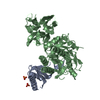 2pmwS S: Starting model for refinement |
|---|---|
| Similar structure data |
- Links
Links
- Assembly
Assembly
| Deposited unit | 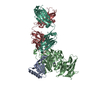
| ||||||||
|---|---|---|---|---|---|---|---|---|---|
| 1 |
| ||||||||
| Unit cell |
|
- Components
Components
-Proprotein convertase subtilisin/kexin type ... , 2 types, 2 molecules AB
| #1: Protein |  PCSK9 / Proprotein convertase PC9 / Subtilisin/kexin-like protease PC9 / Neural apoptosis-regulated ...Proprotein convertase PC9 / Subtilisin/kexin-like protease PC9 / Neural apoptosis-regulated convertase 1 / NARC-1 PCSK9 / Proprotein convertase PC9 / Subtilisin/kexin-like protease PC9 / Neural apoptosis-regulated ...Proprotein convertase PC9 / Subtilisin/kexin-like protease PC9 / Neural apoptosis-regulated convertase 1 / NARC-1Mass: 14107.839 Da / Num. of mol.: 1 / Fragment: UNP residues 31-152 Source method: isolated from a genetically manipulated source Source: (gene. exp.)   Homo sapiens (human) / Gene: NARC1, PCSK9, PSEC0052 / Cell line (production host): Hi-Five / Production host: Homo sapiens (human) / Gene: NARC1, PCSK9, PSEC0052 / Cell line (production host): Hi-Five / Production host:   Trichoplusia ni (cabbage looper) Trichoplusia ni (cabbage looper)References: UniProt: Q8NBP7,  Hydrolases; Acting on peptide bonds (peptidases); Serine endopeptidases Hydrolases; Acting on peptide bonds (peptidases); Serine endopeptidases |
|---|---|
| #2: Protein |  PCSK9 / Proprotein convertase PC9 / Subtilisin/kexin-like protease PC9 / Neural apoptosis-regulated ...Proprotein convertase PC9 / Subtilisin/kexin-like protease PC9 / Neural apoptosis-regulated convertase 1 / NARC-1 PCSK9 / Proprotein convertase PC9 / Subtilisin/kexin-like protease PC9 / Neural apoptosis-regulated ...Proprotein convertase PC9 / Subtilisin/kexin-like protease PC9 / Neural apoptosis-regulated convertase 1 / NARC-1Mass: 57328.645 Da / Num. of mol.: 1 / Fragment: UNP residues 153-692 / Mutation: N533A Source method: isolated from a genetically manipulated source Source: (gene. exp.)   Homo sapiens (human) / Gene: NARC1, PCSK9, PSEC0052 / Cell line (production host): Hi-Five / Production host: Homo sapiens (human) / Gene: NARC1, PCSK9, PSEC0052 / Cell line (production host): Hi-Five / Production host:   Trichoplusia ni (cabbage looper) Trichoplusia ni (cabbage looper)References: UniProt: Q8NBP7,  Hydrolases; Acting on peptide bonds (peptidases); Serine endopeptidases Hydrolases; Acting on peptide bonds (peptidases); Serine endopeptidases |
-Antibody , 2 types, 2 molecules LH
| #3: Antibody |  Fragment antigen-binding Fragment antigen-bindingMass: 22626.869 Da / Num. of mol.: 1 Source method: isolated from a genetically manipulated source Source: (gene. exp.)   Homo sapiens (human) / Production host: Homo sapiens (human) / Production host:   Escherichia coli (E. coli) Escherichia coli (E. coli) |
|---|---|
| #4: Antibody |  Fragment antigen-binding Fragment antigen-bindingMass: 25489.293 Da / Num. of mol.: 1 Source method: isolated from a genetically manipulated source Source: (gene. exp.)   Homo sapiens (human) / Production host: Homo sapiens (human) / Production host:   Escherichia coli (E. coli) Escherichia coli (E. coli) |
-Non-polymers , 2 types, 569 molecules 


| #5: Chemical | ChemComp-NA / |
|---|---|
| #6: Water | ChemComp-HOH /  Water Water |
-Details
| Sequence details | AUTHORS STATE THAT RESIDUE GLY B 620 IS A MUTATION THAT WAS LIKELY INTRODUCED |
|---|
-Experimental details
-Experiment
| Experiment | Method:  X-RAY DIFFRACTION / Number of used crystals: 1 X-RAY DIFFRACTION / Number of used crystals: 1 |
|---|
- Sample preparation
Sample preparation
| Crystal | Density Matthews: 5.18 Å3/Da / Density % sol: 76.23 % |
|---|---|
Crystal grow | Temperature: 293 K / Method: vapor diffusion, sitting drop / pH: 8.3 Details: 0.1 M Tris-HCl, 0.2 M Sodium acetate, 10-15% PEG 4000, 3-6% Dextran sodium salt (Mr 5000), pH 8.3, VAPOR DIFFUSION, SITTING DROP, temperature 293K |
-Data collection
| Diffraction | Mean temperature: 100 K |
|---|---|
| Diffraction source | Source:  SYNCHROTRON / Site: SYNCHROTRON / Site:  ALS ALS  / Beamline: 5.0.2 / Wavelength: 1 Å / Beamline: 5.0.2 / Wavelength: 1 Å |
| Detector | Type: ADSC QUANTUM 315 / Detector: CCD |
| Radiation | Monochromator: Si(111) Double crystal / Protocol: SINGLE WAVELENGTH / Monochromatic (M) / Laue (L): M / Scattering type: x-ray |
| Radiation wavelength | Wavelength : 1 Å / Relative weight: 1 : 1 Å / Relative weight: 1 |
| Reflection | Resolution: 2.3→40 Å / Num. all: 107766 / Num. obs: 107766 / % possible obs: 99.9 % / Observed criterion σ(F): 0 / Observed criterion σ(I): 0 / Redundancy: 3.5 % / Biso Wilson estimate: 42.3 Å2 / Rmerge(I) obs: 0.079 / Net I/σ(I): 11 |
| Reflection shell | Resolution: 2.3→2.42 Å / Redundancy: 3.6 % / Rmerge(I) obs: 0.589 / Mean I/σ(I) obs: 2.5 / Num. unique all: 15651 / % possible all: 100 |
-Phasing
Phasing | Method:  molecular replacement molecular replacement |
|---|
- Processing
Processing
| Software |
| ||||||||||||||||||||||||||||
|---|---|---|---|---|---|---|---|---|---|---|---|---|---|---|---|---|---|---|---|---|---|---|---|---|---|---|---|---|---|
| Refinement | Method to determine structure : :  MOLECULAR REPLACEMENT MOLECULAR REPLACEMENTStarting model: PDB entry 2PMW Resolution: 2.3→40 Å / Occupancy max: 1 / Occupancy min: 0.5 / Cross valid method: THROUGHOUT / σ(F): 0 / Stereochemistry target values: Engh & Huber
| ||||||||||||||||||||||||||||
| Displacement parameters | Biso max: 117.99 Å2 / Biso mean: 46.497 Å2 / Biso min: 18.25 Å2 | ||||||||||||||||||||||||||||
| Refinement step | Cycle: LAST / Resolution: 2.3→40 Å
| ||||||||||||||||||||||||||||
| Refine LS restraints |
| ||||||||||||||||||||||||||||
| LS refinement shell | Resolution: 2.3→2.32 Å
|
 Movie
Movie Controller
Controller





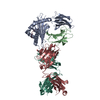
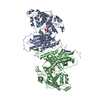
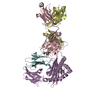

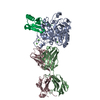


 PDBj
PDBj





